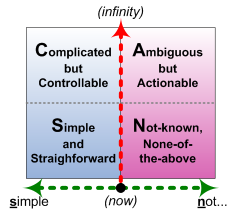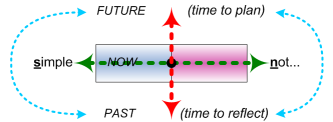Real-time sensemaking with SCAN
What do we do when we don’t know what to do? – and how do we ensure that whatever we do is the right thing to do? How do we make sense fast, at business-speed?
I’ve been tussling with this one for quite a while, most recently culminating with a simple sensemaking framework called SCAN:

The horizontal green-line axis here represents the decision-type, from a simple true/false choice to a not-so-simple modal choice of possibility and necessity; the vertical red-line axis is the amount of time available before must make a choice and take action.
[For more on SCAN and its technical background, see the posts ‘“Let’s do a quick SCAN on this”‘ and ‘Domains and dimensions in SCAN‘.
In a sense, though, that red line of ‘available-time’ goes both sides of the ‘now’, extending outward both into future plans and past record:
Time and distance and even social-distance all compress down towards the point of decision, the moment of action, the now. That ‘now’-moment is the only one that matters: prior to that point, every ‘decision’ may be nothing more than a vague statement of intent, which may not actually happen in practice – as I know only too well…
At each moment of ‘right here, right now‘, it’s always our responsibility – our ‘response-ability’, our individual and personal ability to respond.
The ‘now’ is the still-point at the centre of action. Yet it’s an active stillness, and there are still choices there in that moment. So what we aim for in this kind of real-time sensemaking is to create just enough space to enhance that ‘ability to respond’ – enough space to enable appropriate choice for appropriate action.
If we don’t create that space for choice, the only ‘choices’ we have come from habit – which may not be appropriate to to the context – or the various ‘hard-wired’ reflex-responses, such as ‘fight’, ‘flight’ or ‘freeze’.
[The other natural-reflex is ‘fornicate’, but we’d, uh, best leave that out of the conversation for now…? 😐 ]
Whilst it’s easy enough to describe what goes on either side of that choice-point, it’s surprisingly hard to describe the choice-point itself without sounding somewhat mystical. Rather like the cosmological moment of the Big Bang, it’s both technically and literally a moment of chaos, within which the ‘normal rules’ break down, and which contains within itself every possibility and every other point.
This is the literal meaning of Pan, by the way – ‘the everything’. If we can’t cope with this infinity of (im)possibility, we’re like to fall into panic. And that’s what leads to those three reflex-responses – each of which rejects the uncertainty in their own distinct way:
- fight: grab at a single possibility and ‘take control’ (whether or not that single chosen option is appropriate to the needs of the context)
- flight: ‘run away’ from the choice (such as to a ‘considered-sensemaking’ framework which cannot work at real-time, and hence leads to some variant of ‘analysis-paralysis’)
- freeze: do nothing and hope that the need for choice will go away (which only works if there’s no actual need for choice or action)
What we need to do instead is stay within the ‘chaos’ for as long as we can, to allow the appropriate choice to emerge from and with the context itself. Describing this as ‘act / sense / respond’ is way too simplistic: it’s more like a real-time dance of choice and action, a transitory yet immensely powerful condition of flow that is often experienced as a kind of ‘no-time’ that is seemingly beyond time.
[People who can hold that space are often described – or derided – as ‘eccentric’, ‘the crazy ones‘. Yet ‘eccentric’ is literally away from the centre – and that’s the place where change can happen, because that distance also provides leverage for change. Being seen as ‘eccentric’ can be difficult at times, but it’s certainly important…]
What I’ve been working on over the past few days or so is trying to a detailed mapping of what actually happens in the real-time space, using this specific question of real-time sensemaking as the ‘target problem’ to keep in focus.
[As usual, I’ve gone back to first-principles to do this, so in effect I’ve been watching myself at work whilst doing this work. What I’ve been seeing may not be the way that others do this, of course, but it actually does match up quite well with what’s in the rather eclectic mix literature that I happen to know, from Lao Tse’s Tao Te Ching to Csíkszentmihalyi’s Flow, and from Zen and the Art of Motorcycle Maintenance, to The Art of Scientific Investigation. So no claims to be ‘academic’ as such, but that isn’t the point: I’m a practical toolmaker, not a ‘pure’ theorist, after all.]
For this, I’ve used the ‘time-compressed’ version of SCAN, in which everything is squeezed down to a real-time choice of tactics, between ‘Simple’ and ‘Not-simple’:

The crucial boundary on this dimension is what I’ve called ‘the Inverse Einstein test’:
- if we do the same thing and get the same results, it’s on the Simple side of the story – so we would attempt to use Simple-side tactics
- if we do the same thing and get different results, it’s on the Not-simple side of the story – so we would need to use tactics from the Not-simple side
In real-time sensemaking we actually swing back and forth between these ‘domains’, using a variety of real-time checks to tell use which side we need to be on at any one moment. They’re different disciplines: but by swinging back-and-forth in a conscious and deliberate way, we maintain an overall discipline at all times.
[First-hand example: doing a formal back-massage. At first, I’ll follow the rules, following the standard sequence of moves and work-patterns, using that pattern itself as a focus. At some point it switches into that ‘flow-state’, and I’ll find myself doing something subtly different, applying pressure in a different way, following kind of ‘inner instructions’ that seem to come through my hands themselves. Then, just as suddenly, the ‘flow-state’ fades, leaving me feeling a bit lost, like I don’t where I am, I don’t know what to do. That’s when the key-phrase ‘Don’t Panic!’ comes in, and reminds me to go back to ‘the rules’ – back to the Simple-side – and follow that pattern until the ‘flow-state’ returns. Which it may not, of course – but at least I’ll have done something useful simply by following ‘the rules’.]
If I use the tags ‘[S]’ for Simple-side, and ‘[N]’ for the Not-simple side, these are some of the points I’ve noticed during this week about that real-time back-and-forth:
— [S] is about following the instructions, following ‘the rules’; [N] is about allowing ‘the answers’ to arise in whatever way they seem to choose.
— [N] is what we do while that ‘inner knowing’ lasts; [S] is what we do when the knowing fades.
— Both sides need calm, and need discipline – including the discipline about how and when to switch back and forth between them.
— [S] has notions of ‘truth’, of ‘control’, of certainty, “I know what to do”; [N] calls for a kind of faith, a lot of trust, perhaps Susan Jeffers‘ “feel the fear and do it anyway” – and often a difficult balance between “do something, don’t just stand there!” and “don’t ‘do something, just stand there…”.
— In a rework of the old slogan “think global, act local”, [S] seems to focus on ‘act local’, whilst [N] seems to allow the broader space of ‘aware global’ – no time to stop and think at real-time, yet use that deep-space of ‘the everything’ to help maintain the big-picture awareness.
— [S] seems to work best with rules or checklists – which is hardly surprising since in essence it thrives on real-time certainties. Some of the rules and checklists I use a lot in real-time sensemaking for enterprise-architecture include:
- allow the uncertainty to be uncertain (i.e. keep gently returning to the Not-simple side)
- don’t try to control – allow ‘the answers’ to arise in their own way
- use the ‘checklist for checklists‘ to create checklists on-the-fly with whatever ideas I’ve gleaned from the Not-simple side
- use quick enquiry-techniques such as ‘Five Whys‘ to push into the Not-simple side for new ideas and information
- use Five-Whys to move up the scale of abstraction towards core-purpose
- use Five-Hows to move down the scale of abstraction towards real-world implementation
- use the R5 set of system-thinking principles – rotation, reciprocation, resonance, recursion, reflexion – to look for factors and patterns in the context
- use the REAL checklist – reliable, efficient, appropriate, elegant – to test for effectiveness themes (sometimes extended to ‘LEARN’ with the addition of ‘integrated’)
- use the tetradian set – physical, virtual/conceptual, relation/emotional, aspirational/spiritual – to review asset-dimensions in a context
- use the Five Elements set – Purpose, People, Preparation, Process, Performance – to assess balance across strategy, tactics and operations (which also aligns with the Tuckman project-lifecycle sequence ‘forming, storming, norming, performing, adjourning’)
— Almost by definition, [N] doesn’t seem to have any clear patterns: the only ‘patterns’ I see myself doing all too often on that side are ones about how to avoid making sense, such as running away to check emails or make yet another cup of tea… 🙁
Anyway, that’s it for the moment. It’s just a work in progress, as usual, but make of it what you will.
Comments/suggestions, anyone?

Leave a Reply